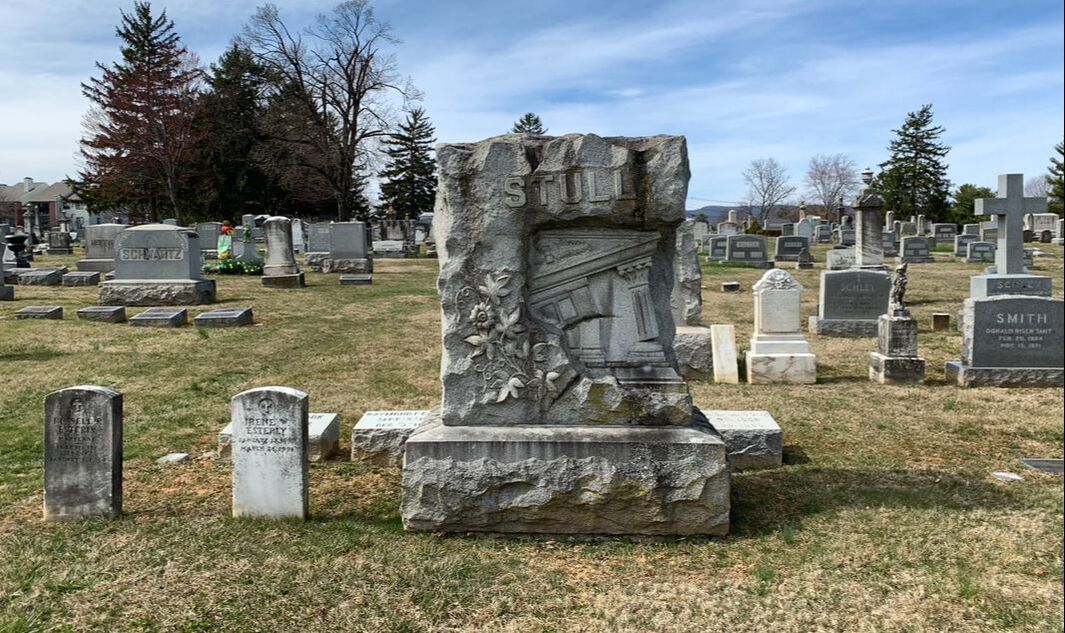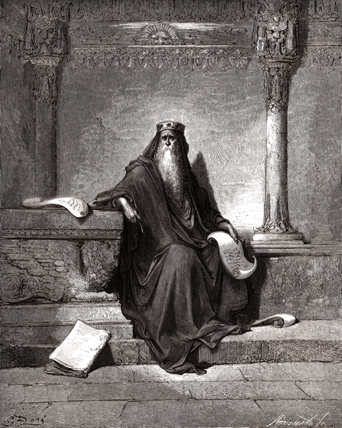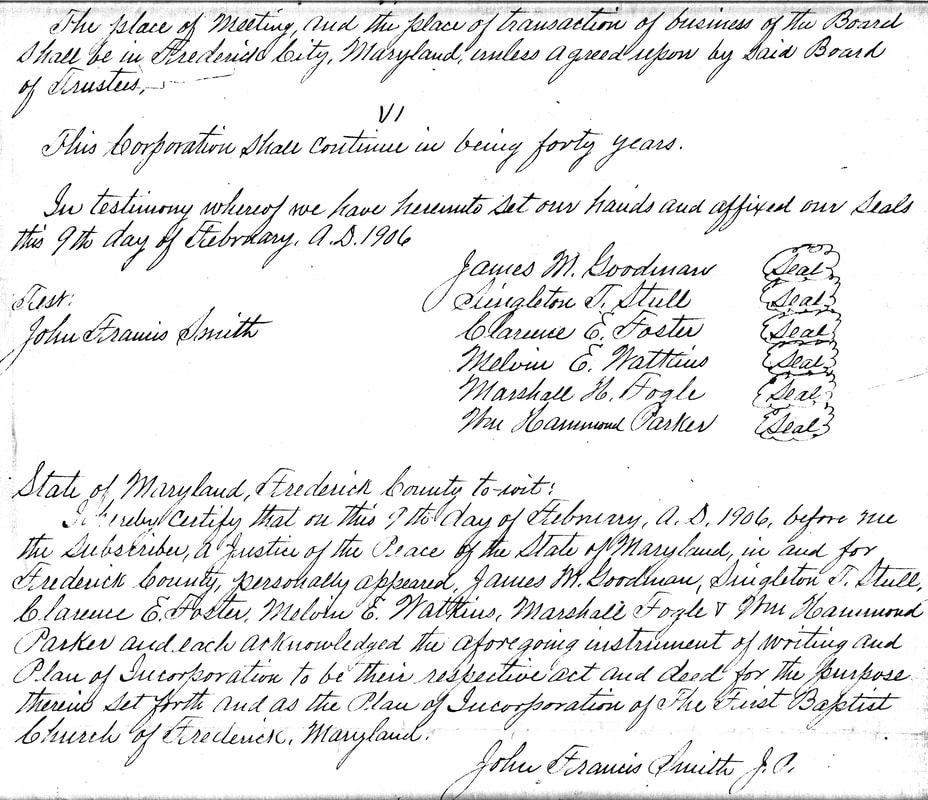|
The cemetery is abuzz with the sound of mowers and weed trimmers. If you listen real close, you may even here the buzz of a bee, or the chirp of a bird. Leaves are starting to grow back on trees, and flowers are slowly coming up. Spring officially sprung on March 20th, but it is really feeling like it now with warmer temperatures and the unmistakable sound of “the crack of the bat” coming from our “personified” next door neighbors (Grove Stadium and Loats Field). A fascinating monument in Mount Olivet’s Area T has had my eye for a number of years. At first glance, it looks like is a large, rough-hewn boulder, but the intricate artwork depicted on its face makes it truly one of a kind here in “Frederick’s Other City.” The symbolism involved is open to interpretation, but after polling several folks here from the cemetery staff and our Friends group, I think I have a good sense of the message being sent through its design. The monument on Lot #66 belongs to a couple by the names of Singleton and Emma Stull, and features an ancient building, seemingly a temple, in a state of freefalling collapse. Carved by hand, the structure is crafted to appear as if enshrined within the shell of the larger boulder. On exterior of the outer shell, we find second artistic element, and another can be found as well on the temple. One is a strand, or vine, of flowers in full bloom, and the other is a lone feather.
A better theory is that this artwork could represent the tower of Siloam, discussed in Luke 13:4. In the Gospel of Luke, Jesus refers to the tower's collapse and the death of the 18 individuals in a discourse on the need for individual repentance for sin. Of course, repentance is the way provided for believers to become free from sins and receive forgiveness for them. Repentance is also required as part of the admission process and approved passage through the famed “Pearly Gates” as well. So there are a couple of explanations of a crumbling structure. The irony lies in the fact that the Stull surname comes from the German word “stolle,” which means support or frame. As such, the name may have been an occupation moniker for a carpenter or other builder. Interesting that we have an unstable and “non-supported” temple depicted on the Stull stone. As an aside, when I saw the word “stolle,” I immediately thought of Christmas tradition German fruitcake called “stollen.” Wait, why am I reminiscing about Christmas when I’m supposed to be writing about springtime, or perhaps Easter? Let’s get back on track, shall we. The monument has these flowers carved on its face. What do these mean in context to a crumbling temple? This led me on another search for symbolism. Fast forward and I confidently think I discovered a proper way to explain this beautiful grave monument in the center point of our burying ground. Ironically, it’s only a few steps from our new World War I Memorial Gazebo and Never Forget Garden. The garden and flowers were, dare I say, the dead giveaway to unlocking this gravestone’s “monumental mystery.” Ecclesiastes is a book within the Bible and the word itself translates to “one who convenes an assembly” or simply a preacher. Throughout the book, the writer/author presents a series of questions in search of the purpose or meaning of life. Ecclesiastes 3:1–8 is a well-known passage that deals with the balanced, cyclical nature of life and says that there is a proper time for everything. You may not be a student of the Bible, but if you are a lover of music from the 1960s, you will know this passage in connection with one of the most memorable songs of the 1960s by folk rock legends the Byrds. “There is a time for everything, and a season for every activity under the heavens: a time to be born and a time to die, a time to plant and a time to uproot, a time to kill and a time to heal, a time to tear down and a time to build, a time to weep and a time to laugh, a time to mourn and a time to dance, a time to scatter stones and a time to gather them, a time to embrace and a time to refrain from embracing, a time to search and a time to give up, a time to keep and a time to throw away, a time to tear and a time to mend, a time to be silent and a time to speak, a time to love and a time to hate, a time for war and a time for peace.” You now hopefully have the tune of “Turn, Turn, Turn” and visions of Roger McGuinn and recently departed David Crosby in your head. Both the passage and song pronounce that there is a time for every matter in life, illustrating this fact by juxtaposing opposites consisting of fourteen pairs of contrasting activities as examples of how life is comprised of various seasons. Here is where the famed King Solomon comes into play. Known for his wisdom, this son of David and former king of Israel is credited with building the first temple in Jerusalem. According to the website www.gotquestions.org: “King Solomon points out that human existence is a progressive cycle of beginnings and endings, births and deaths, joy and sorrow, pleasure and pain. Through a series of fourteen contrasting times and seasons of life, he concludes that God is sovereign over them all (Ecclesiastes 3:1–8). God deliberately designs each moment to create the beautiful tapestry of our lives (Ecclesiastes 3:11). As believers, we must trust Him to mix the fibers and strands according to His good purpose (Romans 8:28). Paired with “a time to kill, and a time to heal” is “a time to break down, and a time to build up” (Ecclesiastes 3:3, ESV). In the original Hebrew, the words translated “break down” mean “to cause to fall or collapse, tear down, pull down.” The contrasting term “build up” refers to “develop, enlarge, construct, or increase by degrees or in stages.” Solomon’s “time to break down” and “time to build up” refer to the processes of destruction and reconstruction. As a master builder and developer of ancient architectural wonders, Solomon would have been well acquainted with the need to tear down and remove old, crumbling buildings before rebuilding new structures in their place. In the construction process, there is an appropriate time for both breaking down and building up.” Hmmm, this seems to summarize our Stull stone now doesn’t it? Here we have a collapsing building depicted on a family monument whose surname is synonymous with the concept of building. For goodness sake, the boulder seems like it could double as a lasting remnant of an ancient mountain just as much as a building block for a new structure. In the Old Testament, Jeremiah’s prophecies forecast the breaking down and building up of peoples, nations, and kingdoms (Jeremiah 1:10). He foresaw a future time when God would rebuild and plant so that His people and their land could be restored (Jeremiah 31:27–29). Just as there is a season for every matter under heaven, there is a time to break down and a time to build up. In times when you feel torn asunder, when everything seems to be falling apart, remember and trust that God is rebuilding your life on the firm, unshakable, and everlasting foundation of Jesus Christ (Matthew 7:24–27; Luke 6:46–49; 1 Corinthians 3:10–17; Ephesians 2:19–22). That’s it. The demise of an old building, a metaphor for the cessation of all living things which eventually leads to a new layer of existence– the transformation of rebirth and perhaps that trip to heaven, exemplified by flowers, plants and new leaves on trees. Of course, let’s not forget about springtime and the birds and the bees—or should that be spelled "byrds?" Finally, let’s tackle the last artistic element, a single feather. This can be found on the pediment of the temple and appears to have a small scroll at the tip of the quill which may simply signify “the writing of one’s life story.” As the complete “weight opposite” of a boulder, a feather has spiritual associations. For many, a feather symbolizes that a loved one is watching over them—a guardian angel. They can give a sense of hope and peace to someone experiencing loss and can be a source of strength and “support” for anyone who's loved one has departed. In our case with the Stull stone, I’d like to think that this element represents Emma keeping a watchful eye over husband Singleton, and stepson Russell Esterly. Although we don’t know exactly who the carver of this artistic masterpiece was, we can hypothesize. The monument was likely placed here in Area T/Lot 66 in the year 1920, as this was the year that Mrs. Emma Stull died. A degree of special activity occurred in this part of the cemetery at this time period. As regular readers of this blog may recall, this Area had been converted from farm field to burial ground shortly after Barbara Fritchie was re-interred nearby in 1912. Area MM was the landing spot to removals from the All States Protestant Episcopal graveyard on Carroll Creek in 1913. Area T was likely designed around this time as well, and would be the “Space du jour” for customers to choose from during the activity years of World War I (1917-1919). More specifically, we can mention the Spanish Flu outbreak in fall 1918. We have roughly 50 doughboys and Frederick civilians buried here in Area T—victims of the terrible pandemic. Based on its prominent site along a drive, I presume that this lot was obtained prior to Mrs. Emma Stull’s death from Bright’s Disease on August 4th, 1920. The former Emma Conard was a Frederick native and devoted church member. As the obituary states, Emma was the beloved wife of Singleton T. Stull. In this same lot are the graves of the Mrs. Stull’s husband and adopted son, Russell Philip Esterly (1897-1944), a veteran of World War I who was a bugler with Company A of the 115th Infantry of the 29th Division. His wife, Irene (Wachter) Esterly (1899-1991), is buried alongside him. Now if a gravestone is supposed to reflect the interests or beliefs of the decedent, we should assume this couple to be faithful believers. They were members of the Baptist faith tradition and were more than just ardent churchgoers. The Stulls were 1905 charter members who helped “build” the First Baptist Church of Frederick, the congregation’s new “temple” on Dill Avenue, including being the ones who donated the plot of ground for the original church that stood on Dill Avenue. Back to our stone design, I found it interesting that the Baptists teach that people are born again when they believe that Jesus died for their sin, and was buried, and rose again, and that by believing/trusting in Jesus’ death, burial and resurrection, eternal life shall be granted as a gift by God. Singleton Thomas Stull married Emma in 1873, and I found them living at multiple locations in Frederick. He was born on his father’s farm in Rocky Springs, north of Frederick City on February 27th, 1851, the son of Dennis Stull (1818-1871) and Ann Rebecca Measall (1826-1863). A look at more census records from 1880 and 1900, show that Singleton and Emma lived in town as early as 1880, on North Market Street. At this time, Singleton is listed as a grocer. Sometime after, the couple relocated to Orange, New Jersey where Singleton took up work as a hat maker. They would come back to Frederick by 1900, where we find them on West 4th Street, and fittingly, Singleton Stull lists his profession as carpenter. The stretch of West 4th Street, that was the Stull home in 1900 is now known as Dill Avenue, and they resided at #240. Around 1907, they would move to Braddock, but this was short-lived as a newspaper article states that they moved back to Frederick in 1908. They returned to North Market Street but landed at 619 North Market Street on the northwest corner of what is known as Lord Nickens Way. As it was a “time to build,” Mr. Stull is listed as a builder in 1910, and was doing well as a popular home contractor. One home mentioned as having been built by him is the only house on Frederick’s Dulaney Avenue. On this thoroughfare, named for Frederick’s founder Daniel Dulany, one can travel from Dill Avenue to West 2nd Street. The “born-again builder of structures” would have his step-son (Russell Esterly) return home from Europe safely after participating in the Meuse-Argonne Offensive of World War I in fall of 1918. Sadly, our subject would lose his beloved wife in 1920 as stated earlier. He now had his guardian angel like a feather flowing peacefully in the wind above him. As stated earlier, I believe this is the time he may have designed his stone, but it could have gone in earlier or after. I also think that the monument’s maker (stone mason) was Howard G. Taylor, a North Market Street neighbor (at 118 North Market) who we published a story about back in February 2022. Mr. Taylor operated the Frederick Marble & Granite Works from his home and his own grave is just 20 yards north of the Stulls in Area T/Lot 42. It has the similar feature of a rough-hewn exterior, revealing an inner core that proudly displays the family surname of Taylor above a large feather and beside a partially hidden urn. Singleton would live the rest of his life with his stepson and daughter in law at 232 West 5th Street. He would die on September 1st, 1930 and be laid to rest next to Emma, and both boast very modest foot stones with their initials and dates of birth and death. In closing, I’d like to bring one additional find associated with this magnificent grave monument, a lasting legacy to a couple whose last name “Stull” translates from German “stolle” to mean frame or build. You just can’t make this stuff up. I wonder if Mr. Stull decided to eat a piece of that earliest fruitcake (made by Mrs. Stull in 1870) on the occasion of its 60th year? And if there is any left in a tin box somewhere, it would be 153 this year. I’m pretty sure its consumption may have your stomach doing more than “turn, turn, turn”—that’s for sure! To everything turn, turn, turn
There is a season turn, turn, turn And a time to every purpose under Heaven A time to be born, a time to die A time to plant, a time to reap A time to kill, a time to heal A time to laugh, a time to weep To everything turn, turn, turn There is a season turn, turn, turn And a time to every purpose under Heaven A time to buid up, a time to break down A time to dance, a time to mourn A time to cast away stones A time to gather stones together To everything turn, turn, turn There is a season turn, turn, turn And a time to every purpose under Heaven A time of love, a time of hate A time of war, a time of peace A time you may embrace A time to refrain from embracing To everything turn, turn, turn There is a season turn, turn, turn And a time to every purpose under Heaven A time to gain, a time to lose A time to rain, a time of sow A time for love, a time for hate A time for peace, I swear it's not too late Source: Musixmatch Songwriters: Pete Seeger Turn! Turn! Turn! lyrics © Melody Trails Inc. C/o The Richmond Organizat, Melody Trails Inc.
1 Comment
Terry Eskuchen
4/3/2023 01:18:18 pm
This was a very interesting article, Chris. I’ll have to look at this stone more carefully the next time I am there. Thanks for all your great research.
Reply
Leave a Reply. |
STORIES
|
Archives
July 2024
June 2024
May 2024
April 2024
March 2024
February 2024
January 2024
December 2023
November 2023
September 2023
August 2023
July 2023
June 2023
May 2023
April 2023
March 2023
February 2023
January 2023
December 2022
November 2022
October 2022
September 2022
August 2022
July 2022
June 2022
May 2022
April 2022
March 2022
February 2022
January 2022
December 2021
November 2021
October 2021
September 2021
August 2021
July 2021
June 2021
May 2021
April 2021
March 2021
February 2021
January 2021
December 2020
November 2020
October 2020
September 2020
August 2020
July 2020
June 2020
May 2020
April 2020
March 2020
February 2020
January 2020
December 2019
November 2019
October 2019
September 2019
August 2019
July 2019
June 2019
May 2019
April 2019
March 2019
February 2019
January 2019
December 2018
November 2018
October 2018
September 2018
August 2018
July 2018
June 2018
May 2018
April 2018
March 2018
February 2018
January 2018
December 2017
November 2017
October 2017
September 2017
August 2017
July 2017
June 2017
May 2017
April 2017
March 2017
February 2017
January 2017
December 2016
November 2016

































 RSS Feed
RSS Feed